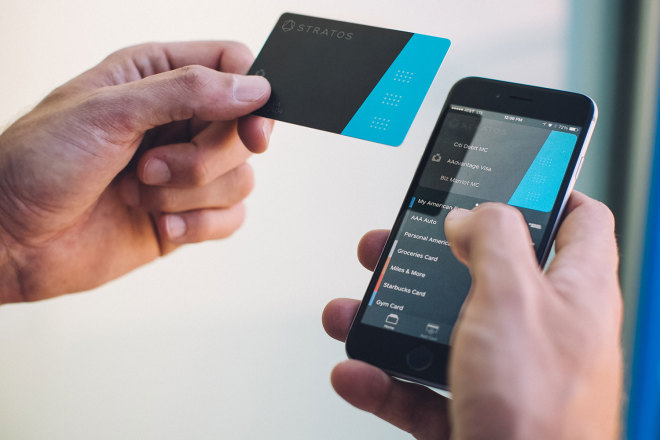
New Connected Credit Card Aims To Succeed Where Coin Failed
WIRED: Remeber Coin, the credit card-sized gizmo that promised to streamline your wallet by consolidating all your other, actual credit cards? It raked in approximately a gazillion dollars in pre-orders when it debuted in November 2013, only to become another certified crowdfunding debacle, beset by delays and acrimony. Buyers were initially told it would ship summer 2014; the vast majority are still waiting. If nothing else, the saga proved that there is interest in a wallet-slimming wonder card. Now, those interested have another option to consider. Stratos is more or less the same concept as Coin, just with a slicker design and one other key advantage: Its creators claim it’s actually ready to ship. The question is whether or not it will be relevant once the payment world starts the shift to chip-enhanced cards this fall.
One Card Fits All
If you remember Coin, you’re already familiar with the basic idea behind Stratos. You load your credit and debit cards into a smartphone app with a provided dongle, and they reside electronically on the Stratos card itself. From there, you can use them via the device anywhere you’d use the original.
The Bluetooth-equipped card, designed by Herbst Produkt, has a handsome design and a few especially nice touches. For one, while it can hold an unlimited number of cards, three touch-sensitive shortcuts on the device itself let you quickly pull in your most frequently-used cards. The rest—including rewards and membership cards and the like—can be summoned by tapping the device to your phone and selecting the desired one from an app. As designer Scot Herbst puts it, the aim was to streamline the interactions and to keep the card-switching from feeling cumbersome or kludgey.
The Stratos team, based in Ann Arbor, MI, has been working on the device for three years. CEO Thiago Olson says he and his co-founders made a deliberate decision to keep their heads down while they worked on the technology, to make sure they could deliver when they did debut. “Switching from the R&D to the manufacturable card is so hard,” he says. At this point, their manufacturer is pumping out cards and the company plans to start shipping them in April.
Credit Cards Are A-Changin’
Even if Stratos is the one card to rule them all, it won’t last forever. October is the suggested deadline for retailers to switch over to a more secure standard called EMV. Instead of swiping your card and transmitting data via the magnetic strip, you dip your card and the point of sale device reads an embedded chip. It’s the same thing they’ve used in Europe for years under the name “chip and pin.”
The first current version of Stratos won’t be able to replicate the chip-based transactions. Granted, even with the October deadline, there will likely be a transition period as merchants and card issuers get sorted out with the new technology. But at some point, people are going to stop accepting the old school swipe-based transactions, and when that does happen, your first-gen Stratos will become a nice hefty bookmark. There’s a good chance the first version of Stratos will be largely outmoded in a matter of months.
Olson and company are actively trying to figure out a second-generation Stratos that will make sense in this landscape. One of the ideas they’re considering is a card that could make tokenized payments from your other cards via magnetic stripe or NFC—essentially Apple Pay in credit card form. Olson also has visions of a platform where digital cards could be issued securely and instantaneously; Stratos is in talks with networks and issuers about this sort of system. In an effort to future-proof their offering, Stratos is launching with a subscription model and promising to send all users a new card with whatever next-gen tech they decide on every year. Memberships start at $95 for one year and $145 for two. Still, Olson readily admits that payments are a rapidly changing space. Stratos’ future is anything but guaranteed.
But Olson is confident that there’s room for some sort of credit card in our future, even with changing standards and the rise of mobile payments. Apple Pay and the like will be fine for when you’re in Whole Foods, he says, but what about when you’re in a restaurant? You’re not going to hand your phone to the waiter. Perhaps more importantly, we’re still a long ways from ubiquity. We’ve got years of “can I pay with my phone here?” limbo ahead. Not so with the trusty credit card. “From a consumer side, you don’t really have to worry about where it works. It works everywhere,” Olson says. “We don’t view the card as an artifact that’s going away.”





